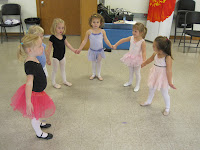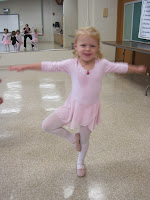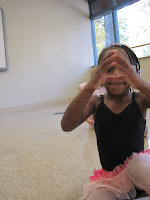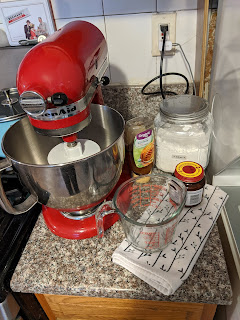Literacy and Dance
Language arts....arts? Could there be a link? The term "language arts" suggests that there is a correlation between literacy and the arts, but the arts aren't always used in learning language. Sure, there are pictures in books. Sometimes teachers have students draw their own pictures to stories. Webs, tables, and story graphics are used. Occasionally, music is set to a story or vice versa. Students will act out stories, or use puppetry, etc. to bring the theatrical elements in to the language arts. But what about dance? Rarely do we ever see students dancing during their language time. Dance should be used much more, because dance is story telling.
Let me first explain the characteristics needed in both literacy and dance. First, there is the distinction between left and right. We read and write left to right, but you also need to know the difference in dance. Also, breath is needed. There is breath between movements, breath between speaking words or sentences, and the breath between thoughts while writing. Fluidity is necessary. The flow of words and movements make literacy and dance more understandable. Concentration, fine motor skills, lengthy attention span, and so much more. (I have to say that when I first started thinking about and writing this post, I knew what I was going to say. I wanted to see what other people had to say about the topic and I came across a great article that paralleled my thoughts and many activities I had done in my various dance classes. Rea Pica wrote the article and has a lot of wonderful ideas. I encourage you to check out her website.)
Let's go back to the thought that "dance is story telling". We put words together to create sentences, then paragraphs, then stories. We need to put movements together to convey a message, as well. Just like adding punctuation, dancers need to add facial expressions and body placement to achieve the understanding of an emotion. Dance, just like words, has syllables. Dancers find rhythm in the music or the movements, and we can find rhythm in words, stories and poems. We have all clapped out syllables before, right? I can remember clapping out the syllables of my name when learning what syllables meant. Do you remember this? Why not add movements instead of claps? An author's experiences, emotions, ideas, and thoughts create the story. A choreographer's experiences, emotions, ideas and thoughts create a dance. Putting all of these ideas together, it is clear that dance is story telling. So why don't we use dance when learning about stories?
Ok, quiz time. How can you add dance to learning prepositions? That was an easy one. Have the students move throughout a room to physically interact with prepositions (under, over, through, etc.). After the students have learned the basic prepositions and where their bodies would move, link the prepositions together and create a classroom preposition dance. They can move from "over" to "under" by adding some simple movements in between. Then, voila, you have a dance!
At this time, I am working with a great number of 4 year old Pre-Ballet dancers. They are pre-ballet, pre-reading, pre-writing and preschool! Having an education background, I love to add educational elements to my ballet classes. We began exploring letters with our bodies. This will give the students a concrete understanding of the shapes that letters make and also the shapes a body can make. The visions of making letters with their bodies may creep into their minds as they are asked to write their names, or the ABC's. This is a fun way of linking literacy and dance. They had a blast!
There is a clear connection between literacy and dance. If we want to provide our students with rich learning experiences, we need to incorporate dance. These experiences will stay with them. They were having so much fun, they didn't realize how much they were learning. Why isn't this how we learn during school?
P.S. Sorry for how lengthy this post ended up being.
Let me first explain the characteristics needed in both literacy and dance. First, there is the distinction between left and right. We read and write left to right, but you also need to know the difference in dance. Also, breath is needed. There is breath between movements, breath between speaking words or sentences, and the breath between thoughts while writing. Fluidity is necessary. The flow of words and movements make literacy and dance more understandable. Concentration, fine motor skills, lengthy attention span, and so much more. (I have to say that when I first started thinking about and writing this post, I knew what I was going to say. I wanted to see what other people had to say about the topic and I came across a great article that paralleled my thoughts and many activities I had done in my various dance classes. Rea Pica wrote the article and has a lot of wonderful ideas. I encourage you to check out her website.)
Let's go back to the thought that "dance is story telling". We put words together to create sentences, then paragraphs, then stories. We need to put movements together to convey a message, as well. Just like adding punctuation, dancers need to add facial expressions and body placement to achieve the understanding of an emotion. Dance, just like words, has syllables. Dancers find rhythm in the music or the movements, and we can find rhythm in words, stories and poems. We have all clapped out syllables before, right? I can remember clapping out the syllables of my name when learning what syllables meant. Do you remember this? Why not add movements instead of claps? An author's experiences, emotions, ideas, and thoughts create the story. A choreographer's experiences, emotions, ideas and thoughts create a dance. Putting all of these ideas together, it is clear that dance is story telling. So why don't we use dance when learning about stories?
Ok, quiz time. How can you add dance to learning prepositions? That was an easy one. Have the students move throughout a room to physically interact with prepositions (under, over, through, etc.). After the students have learned the basic prepositions and where their bodies would move, link the prepositions together and create a classroom preposition dance. They can move from "over" to "under" by adding some simple movements in between. Then, voila, you have a dance!
At this time, I am working with a great number of 4 year old Pre-Ballet dancers. They are pre-ballet, pre-reading, pre-writing and preschool! Having an education background, I love to add educational elements to my ballet classes. We began exploring letters with our bodies. This will give the students a concrete understanding of the shapes that letters make and also the shapes a body can make. The visions of making letters with their bodies may creep into their minds as they are asked to write their names, or the ABC's. This is a fun way of linking literacy and dance. They had a blast!
"I can make a "Y" and turn it into an "X"!"
The idea on an "x" took off and we found that we could make many "x's" with our bodies.
A classroom full of "x's"! Our whole body, legs, and arms can make "x's".
Sometimes, we had to work together to make letters. What letters do you see?
Upper Left- "H" Above Center- "A's" Upper Right- "A"
Lower Left- "W" Lower Right- "U"
Two little girls wanted to make "T's". The first one realized she could make a "T" and a "4" at the same time!
These girls found that they could use their fingers to make "L's", use the entire body to make an "L", and use the entire body to make a "T".
"I'm making a tiny "O"!"
We can make so many "O's" with our bodies. Check out all of the ways these girls (above) found they could make "O's".
There is a clear connection between literacy and dance. If we want to provide our students with rich learning experiences, we need to incorporate dance. These experiences will stay with them. They were having so much fun, they didn't realize how much they were learning. Why isn't this how we learn during school?
P.S. Sorry for how lengthy this post ended up being.























Comments
Post a Comment